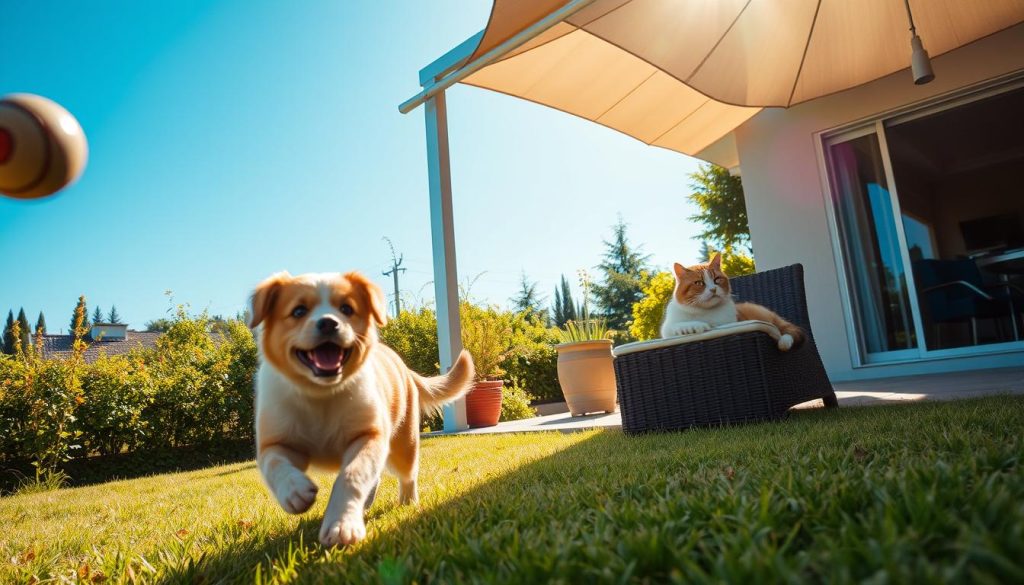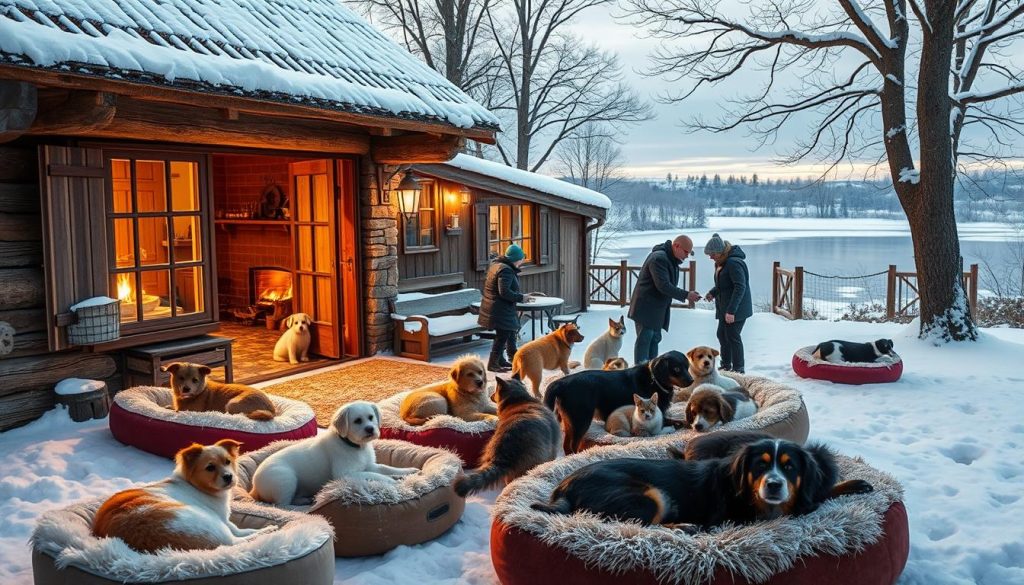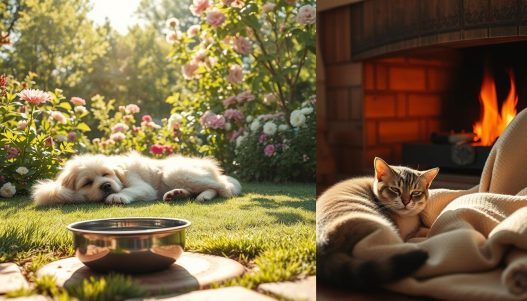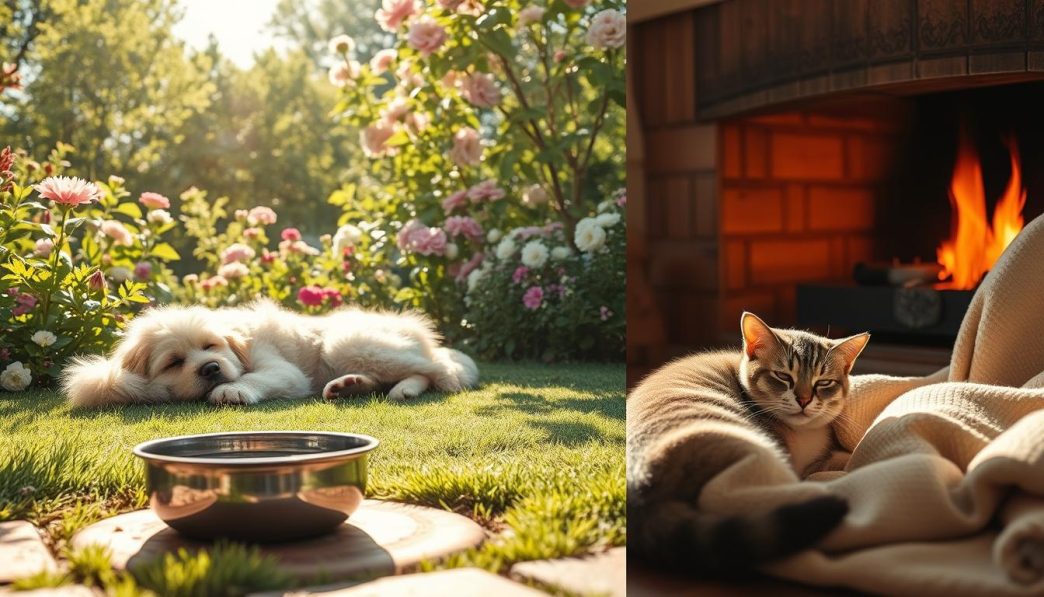As a pet owner, it’s crucial to understand how seasonal changes affect your furry friends. Extreme temperatures can pose significant health risks to your pets, making it essential to adjust your pet care routine accordingly.
During the summer heat, it’s vital to keep your pets cool and hydrated. Conversely, winter cold requires extra precautions to keep them warm and safe. This article will guide you through the necessary adjustments to ensure your pets remain comfortable and healthy throughout the year.
Key Takeaways
- Adjust your pet care routine according to the season.
- Keep your pets cool and hydrated during summer.
- Take extra precautions to keep your pets warm during winter.
- Monitor your pets’ health closely during extreme temperatures.
- Provide a safe and comfortable environment for your pets year-round.
Understanding How Seasons Affect Your Pets
Understanding how different seasons affect pets is vital for providing optimal care. As the environment around them changes, pets require adjustments in their care to stay comfortable and healthy.
How Different Species React to Temperature Changes
Different species and breeds react uniquely to temperature fluctuations. For instance, dogs with thick coats may struggle in the summer heat, while those with short coats may shiver in the winter cold. Recognizing these differences is key to providing appropriate care.
Recognizing Signs of Temperature Discomfort
Pets often exhibit specific behaviors when they are uncomfortable due to temperature changes. These can include panting, shivering, or seeking shade. Being aware of these signs allows pet owners to make necessary adjustments.
Seasonal Adjustments to Pet Care Routines
Making seasonal adjustments to pet care routines can significantly enhance pets’ comfort. This includes modifying their exercise schedule, diet, and grooming needs according to the season. For example, pets may require more hydration during summer and additional warmth during winter.
| Season | Pet Care Adjustment | Benefit |
|---|---|---|
| Summer | Increased hydration, reduced exercise | Prevents dehydration and heatstroke |
| Winter | Additional warmth, adjusted diet | Maintains warmth and energy levels |
Summer Hazards for Pets
As temperatures rise, pets face numerous summer hazards that require immediate attention. The warmer months bring with them a range of dangers, from heat stroke to dehydration risks, making it crucial for pet owners to be aware of the potential threats to their pets’ health.
Heat Stroke: Symptoms, Prevention, and Emergency Response
Heat stroke is a life-threatening condition that occurs when a pet’s body temperature becomes too high. Symptoms include excessive panting, drooling, and lethargy. To prevent heat stroke, keep your pet cool and hydrated, avoid exercising them during the hottest parts of the day, and never leave them in a parked car.
If your pet shows signs of heat stroke, act quickly by moving them to a cooler area, providing cool water, and contacting your veterinarian immediately.
Hot Surfaces and Paw Protection Strategies
Hot surfaces like pavement and sand can cause burns to your pet’s paws. To protect their paws, avoid walking them on hot surfaces during peak sun hours. You can test the surface temperature by placing the back of your hand on the ground; if it’s too hot for you, it’s too hot for your pet.
Dehydration Risks and Water Requirements
Dehydration is a significant risk during the summer months, especially for pets that spend a lot of time outdoors. Ensuring your pet has access to plenty of fresh water is crucial.
Water Consumption Guidelines by Pet Size
| Pet Size | Water Requirement |
|---|---|
| Small (under 20 lbs) | 1-2 cups per day |
| Medium (21-50 lbs) | 2-3 cups per day |
| Large (51-90 lbs) | 3-4 cups per day |
| Extra Large (over 90 lbs) | 4+ cups per day |
Monitoring your pet’s water intake and adjusting according to their size, activity level, and climate can help prevent dehydration.
Creating a Summer-Safe Environment
Summer safety for pets involves more than just providing shade; it’s about creating a comprehensive cooling strategy. As temperatures soar, it’s crucial to ensure your pets have a cool and comfortable environment.
Outdoor Shade Solutions and Cooling Stations
Providing adequate outdoor shade is vital. Canopies, umbrellas, or even trees can serve as effective shade providers. Additionally, consider setting up cooling stations with cooling mats or pads to help lower your pet’s body temperature.
Indoor Climate Control Considerations
Indoor climate control is just as important. Air conditioning is an effective way to keep your home cool. If you don’t have air conditioning, consider using fans or other cooling devices to keep the air circulating.
Pet-Safe Cooling Products and DIY Options
There are various pet-safe cooling products available, such as cooling vests and mats. You can also create DIY cooling solutions, like frozen water bottles wrapped in towels, to provide a cooling effect.
“A cool environment is key to preventing heat-related illnesses in pets.” By implementing these strategies, you can ensure your pets stay safe and comfortable during the summer months.
Summer Exercise and Activity Guidelines
The warm weather of summer demands a change in how we approach exercise and outdoor activities with our pets. As temperatures rise, it’s essential to adjust their routine to prevent heat-related issues.
Optimal Times for Walks and Outdoor Play
To keep your pets safe, consider taking them for walks or engaging in outdoor play during the early morning or late evening when temperatures are cooler. This helps in avoiding the peak heat of the day.
Water Activities for Dogs and Water-Friendly Pets
Water activities can be a great way to keep your pets active and cool. Many dogs enjoy swimming or playing in water, which can be an excellent alternative to traditional exercise on hot days.

Adjusting Exercise Intensity During Heat Waves
During heat waves, it’s crucial to reduce the intensity and duration of your pet’s exercise. Monitor their behavior and watch for signs of overheating, such as panting or lethargy.
| Activity | Normal Weather | Heat Wave |
|---|---|---|
| Walks | 30 minutes | 15 minutes |
| Outdoor Play | 60 minutes | 30 minutes |
| Water Activities | Optional | Recommended |
Summer Grooming and Coat Care
Summer grooming is not just about aesthetics; it’s a crucial aspect of pet care that helps prevent overheating and skin issues. As the weather warms up, your pet’s coat and skin require special attention to keep them comfortable and healthy.
Breed-Specific Summer Grooming Needs
Different breeds have unique grooming requirements during the summer. For instance, dogs with thick double coats, like Siberian Huskies, may need regular brushing to prevent matting, while short-haired breeds might require less frequent grooming. Understanding your pet’s specific needs is key to keeping them cool and comfortable.
Cooling Benefits of Regular Brushing
Regular brushing can have a significant cooling effect on pets. It helps to remove loose fur, improve air circulation to the skin, and distribute natural oils that protect the skin. For many pets, a daily brushing session can be a relaxing and enjoyable experience that also helps to reduce shedding.
Skin Protection and Sunburn Prevention
Protecting your pet’s skin from sunburn is crucial, especially for those with light-colored coats or skin. Using pet-safe sunscreens and providing shade can help prevent sun damage. Regular grooming also allows for the early detection of skin issues, enabling prompt treatment.
| Grooming Activity | Benefits | Frequency |
|---|---|---|
| Brushing | Removes loose fur, improves air circulation, distributes natural oils | Daily/Weekly |
| Bathing | Cleans the coat, removes dirt and allergens | Monthly/As needed |
| Nail Trimming | Prevents overgrowth, reduces injury risk | Every 4-6 weeks |
Seasonal Pet Care: Protecting Pets in Summer Heat and Winter Cold
As the seasons change, it’s crucial to adapt your pet care routine to ensure your pets remain comfortable and healthy. This involves implementing several key strategies that help protect your pets from extreme temperatures and seasonal health issues.
Year-Round Temperature Monitoring Systems
One of the most effective ways to protect your pets is by using year-round temperature monitoring systems. These systems allow you to keep track of temperature fluctuations in your home and outdoors, ensuring that your pets are not exposed to dangerous temperatures. By monitoring the temperature, you can make necessary adjustments to their environment, such as providing additional shade or warmth.
Seasonal Adjustments to Diet and Nutrition
Dietary adjustments are also crucial as the seasons change. In colder months, pets may require more calories to maintain their body heat, while in hotter months, they may need more hydration and potentially fewer calories due to reduced activity levels. Consulting with a veterinarian can help determine the best dietary plan for your pet based on the season.
Veterinary Check-up Schedule for Weather Transitions
Regular veterinary check-ups are vital, especially during weather transitions. These check-ups can help identify any potential health issues early on, ensuring that your pet receives the necessary care. Scheduling visits around the significant seasonal changes (e.g., from winter to spring or summer to fall) can provide valuable insights into your pet’s health and help you make informed decisions about their care.
By implementing these strategies, you can significantly enhance your pet’s comfort and health throughout the year. Temperature monitoring, dietary adjustments, and regular veterinary check-ups form the cornerstone of effective seasonal pet care.
Winter Challenges for Pets
With the onset of winter, understanding and mitigating the risks to pets becomes crucial. As temperatures drop, pets face a range of challenges that can impact their health and well-being.
Cold Weather Tolerance by Species and Breed
Different pets have varying levels of tolerance to cold weather. For instance, some dog breeds with thick coats, such as Siberian Huskies, are more adapted to cold climates than short-haired breeds like Greyhounds. Similarly, some cat breeds are more resilient to cold than others. Understanding your pet’s breed-specific tolerance is key to providing appropriate care during winter.
Frostbite and Hypothermia: Recognition and First Aid
Frostbite and hypothermia are serious risks for pets in cold weather. Frostbite occurs when skin tissue freezes, often affecting extremities like ears, tails, and paws. Hypothermia happens when a pet’s body temperature drops below normal. Recognizing the signs, such as shivering, lethargy, and pale gums, is crucial. If you suspect your pet has frostbite or hypothermia, seek veterinary care immediately.
Ice, Snow, and Chemical Hazards
Winter also brings hazards like ice, snow, and chemicals used for de-icing. Pets can slip on ice, ingest harmful chemicals, or suffer from irritants like salt and ice melts. Being aware of these dangers can help you protect your pets.
Dangers of Antifreeze and Ice Melts
Antifreeze is particularly dangerous as it contains ethylene glycol, which is toxic to pets. Even small amounts can be fatal. Keep antifreeze out of reach, and clean up any spills immediately. When using ice melts, choose pet-friendly products to minimize risks.
By understanding these winter challenges and taking proactive steps, you can help ensure your pet’s safety and comfort during the cold winter months.
Winter Warmth and Shelter Requirements
As winter sets in, ensuring your pets have adequate warmth and shelter becomes a top priority. Providing a warm and cozy environment is crucial for their comfort and health during the cold months.
Indoor Heating Considerations for Different Pets
Different pets have varying needs when it comes to indoor heating. For instance, older pets or those with certain health conditions may require a warmer environment. It’s essential to consider these needs when adjusting your home’s temperature.
Pet-Specific Heating Needs:
- Dogs: Some breeds, like Siberian Huskies, are more tolerant of cold, while others, such as Chihuahuas, may need extra warmth.
- Cats: Generally, cats are comfortable in warmer temperatures, but senior cats may appreciate a heated bed.
- Small Mammals: Animals like rabbits and guinea pigs should be kept in a warm, draft-free area.
Outdoor Housing Specifications for Cold Weather
For pets that spend time outdoors, their housing must be designed to protect them from harsh winter conditions.
| Feature | Description | Benefit |
|---|---|---|
| Insulation | Proper insulation in outdoor shelters | Keeps the cold out and warmth in |
| Draft Protection | Sealing any drafts or gaps | Prevents cold air from entering the shelter |
| Bedding | Using warm, dry bedding materials | Provides comfort and warmth |
Bedding Materials and Insulation Options
The right bedding and insulation can make a significant difference in keeping your pets warm. Materials like straw or foam insulation can be effective.

Winter Paw and Skin Protection
With temperatures dropping, it’s essential to take extra care of your pet’s paws and skin to prevent discomfort and health issues. Winter conditions can be particularly harsh, with cold temperatures, snow, and ice posing significant risks.
Paw Care Routines for Snow and Ice Exposure
Regular paw care is crucial during winter. After walks, wash your pet’s paws with lukewarm water to remove snow, ice, and salt. Dry them thoroughly, paying extra attention to the areas between the toes.
- Use a pet-safe paw balm to moisturize and protect the paws.
- Consider using pet booties for added protection against ice and salt.
Treating and Preventing Dry Winter Skin
Dry winter air can lead to skin irritation and dryness. To combat this, use a humidifier indoors to maintain a healthy moisture level. Regular grooming with a moisturizing shampoo can also help.
Choosing and Fitting Protective Gear
When selecting protective gear like coats or booties, ensure they fit properly and are comfortable for your pet. Look for waterproof and breathable materials that will keep your pet dry and comfortable.
By following these tips, you can help protect your pet’s paws and skin during the winter months, ensuring they remain healthy and comfortable.
Special Considerations for Vulnerable Pets
Some pets are more susceptible to seasonal changes, necessitating special consideration. Vulnerable pets, including senior pets, young pets, and those with chronic health conditions, require adjusted care strategies to ensure their comfort and health throughout the year.
Senior Pets and Weather Sensitivity
Senior pets often experience increased sensitivity to temperature fluctuations. As pets age, their ability to regulate body temperature can diminish, making them more susceptible to extreme weather conditions. Providing a warm, draft-free environment during winter and a cool, shaded space during summer can significantly improve their comfort.
Puppies, Kittens, and Young Pets
Young pets, such as puppies and kittens, have developing regulatory systems and may need extra protection during seasonal changes. Ensuring they have a safe and comfortable environment is crucial, as they may not be able to adapt as well as adult pets to extreme temperatures.
Pets with Chronic Health Conditions
Pets suffering from chronic health issues, such as arthritis, require special care. Arthritis management is particularly important during seasonal transitions.
Arthritis Management Through Seasonal Changes
Managing arthritis in pets involves maintaining a comfortable environment and potentially adjusting their exercise and medication regimens according to the season. Keeping pets active during winter and ensuring they do not overexert during summer can help manage their condition effectively.
Seasonal Pet Emergencies: When to Contact Your Vet
Being prepared for seasonal pet emergencies is vital for ensuring your pet’s health and safety. As a responsible pet owner, it’s crucial to recognize the warning signs that indicate a need for immediate veterinary care.
Summer Emergency Warning Signs
During the summer, pets are at risk of heat-related illnesses. Watch for signs of heat stroke, such as excessive panting, drooling, and lethargy. If you notice any of these symptoms, it’s essential to act quickly.
- Excessive panting or difficulty breathing
- Bright red gums or tongue
- Rapid heartbeat or collapse
Winter Emergency Warning Signs
In the winter, pets can suffer from hypothermia and frostbite. Be aware of shivering, lethargy, and pale gums, as these can be indicators of hypothermia. Frostbite can cause pain and blistering on the skin.
- Shivering or lethargy
- Pale gums or cold skin
- Discoloration or pain in extremities
Building a Seasonal Pet First Aid Kit
A well-stocked first aid kit can provide immediate care in case of an emergency. Include essentials like bandages, antiseptic wipes, and a thermometer.
It’s also a good idea to keep your veterinarian’s contact information handy, along with a list of emergency contact numbers.
Conclusion: Ensuring Year-Round Comfort for Your Pets
Ensuring your pet’s comfort throughout the year is crucial for their overall health and happiness. By understanding how seasonal changes affect your pets and taking proactive steps, you can help maintain their well-being. Proper pet care involves adjusting their diet and exercise routine to suit the changing weather conditions.
Providing a safe and comfortable environment is essential for year-round pet comfort. This includes creating a warm and cozy space during the winter months and a cool and shaded area during the summer. Regular grooming, veterinary check-ups, and a well-balanced diet also play a significant role in maintaining your pet’s overall health.
By following the guidelines outlined in this article, you can help ensure your pet remains comfortable and happy throughout the year. Prioritizing pet care and making seasonal adjustments will help you provide the best possible life for your furry friend.






